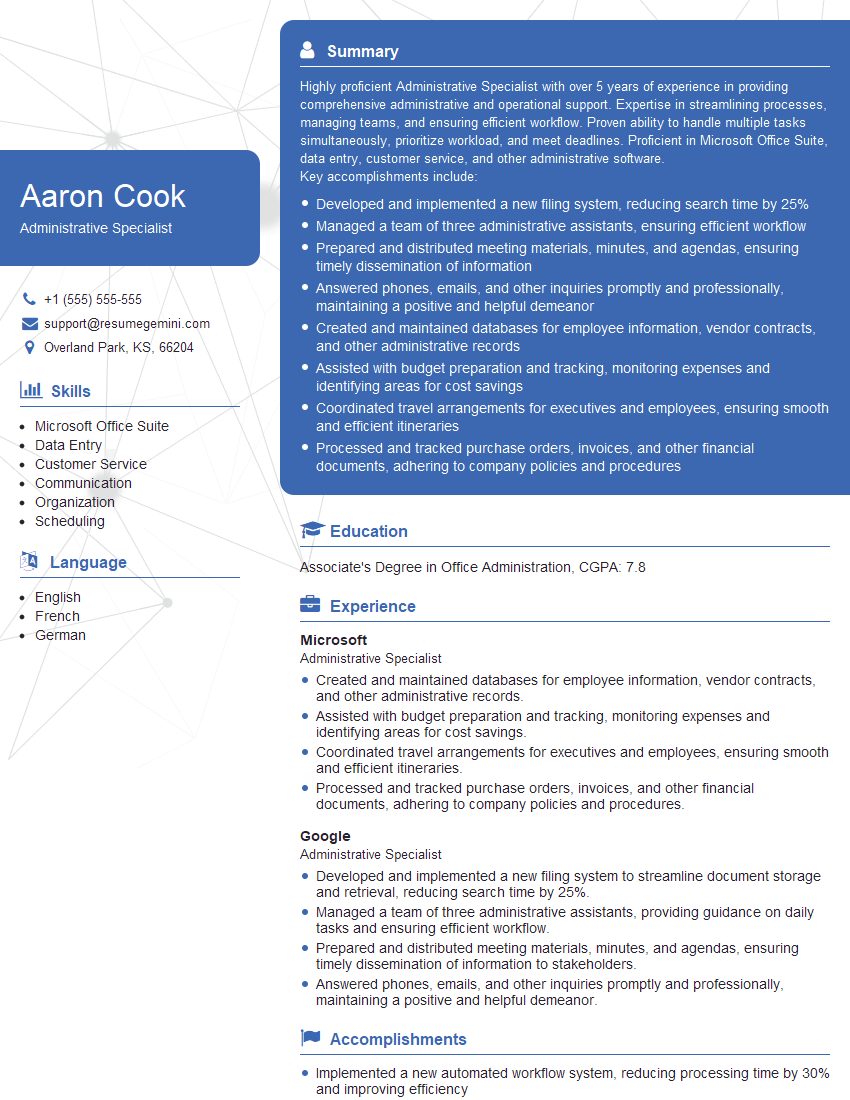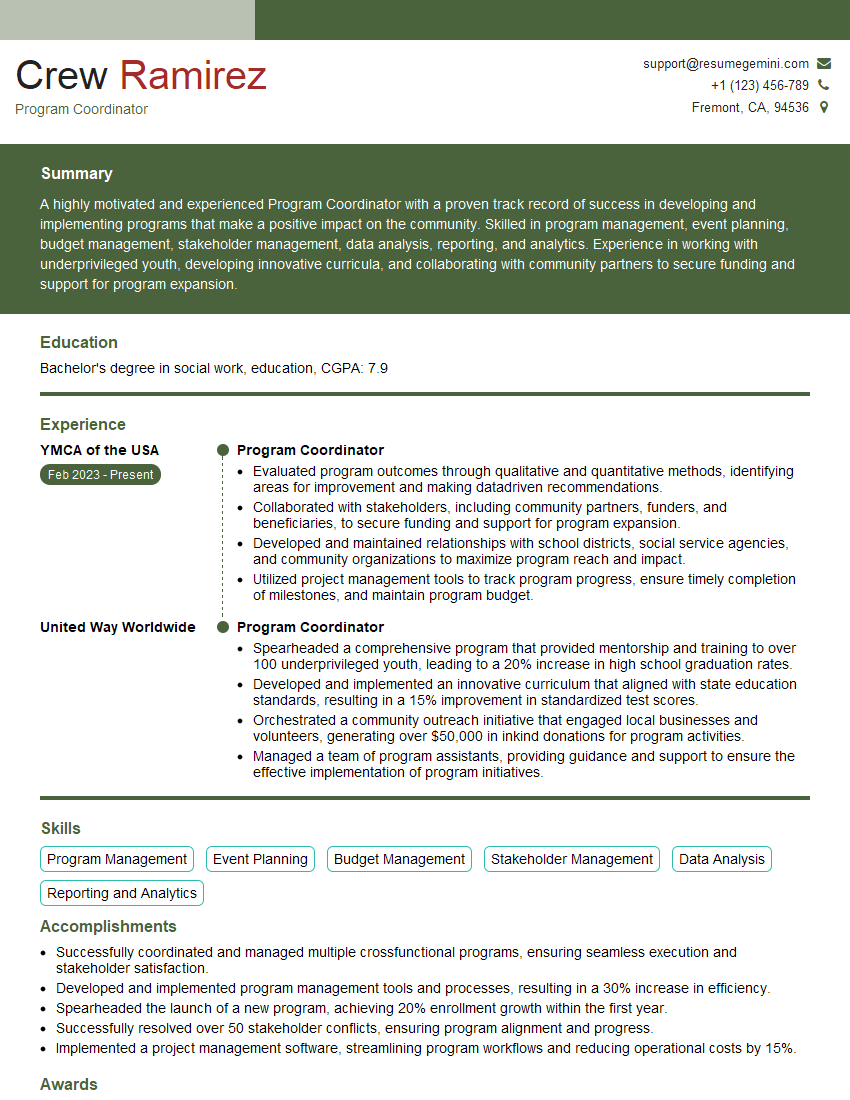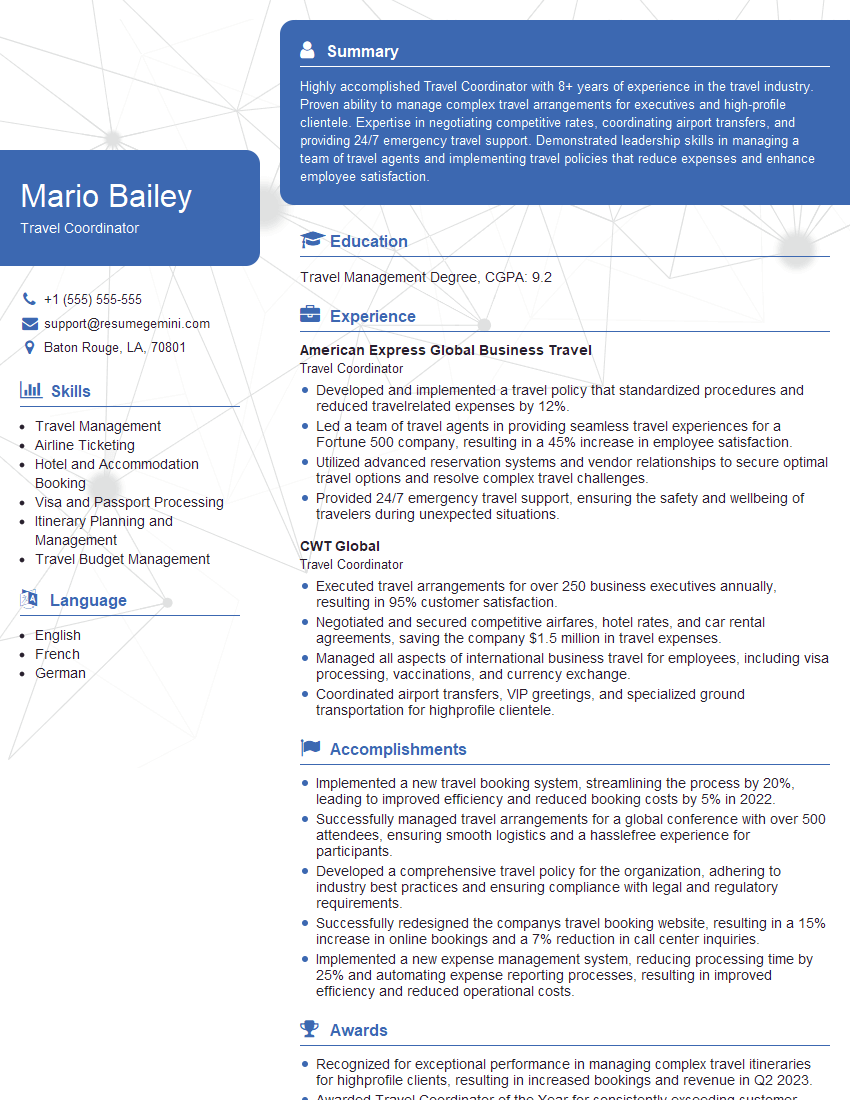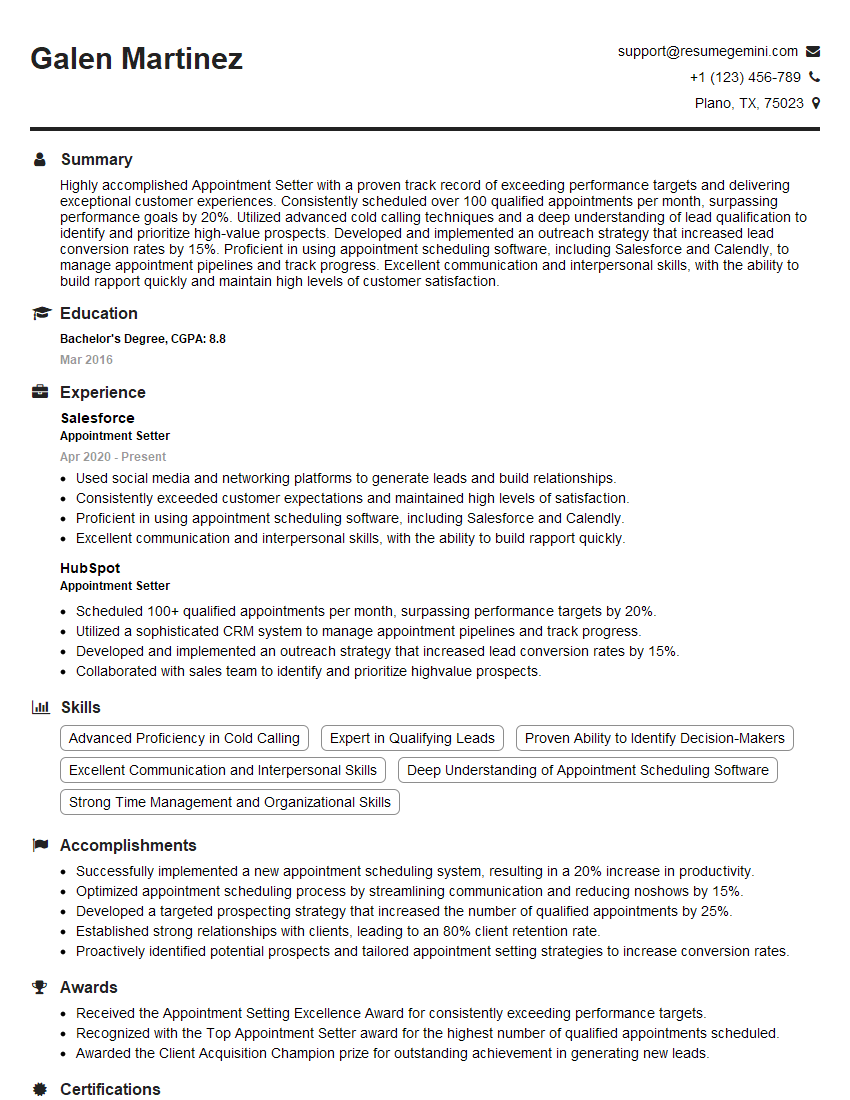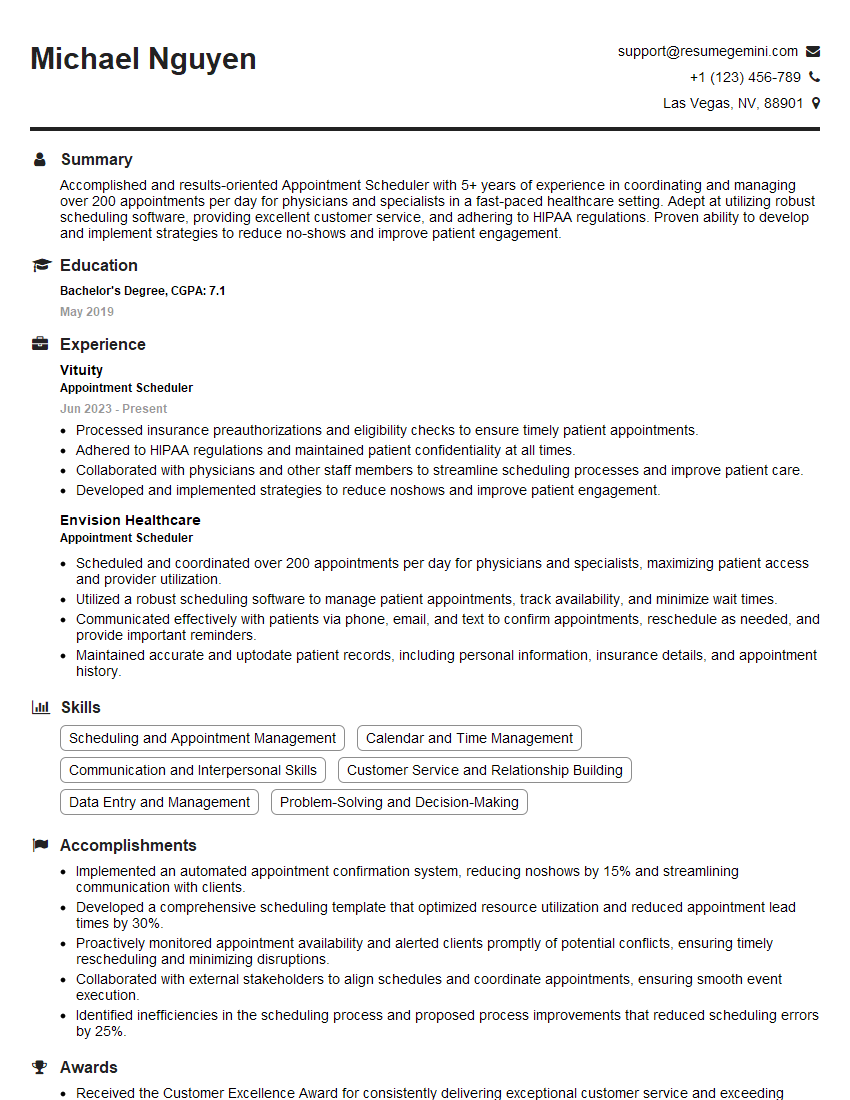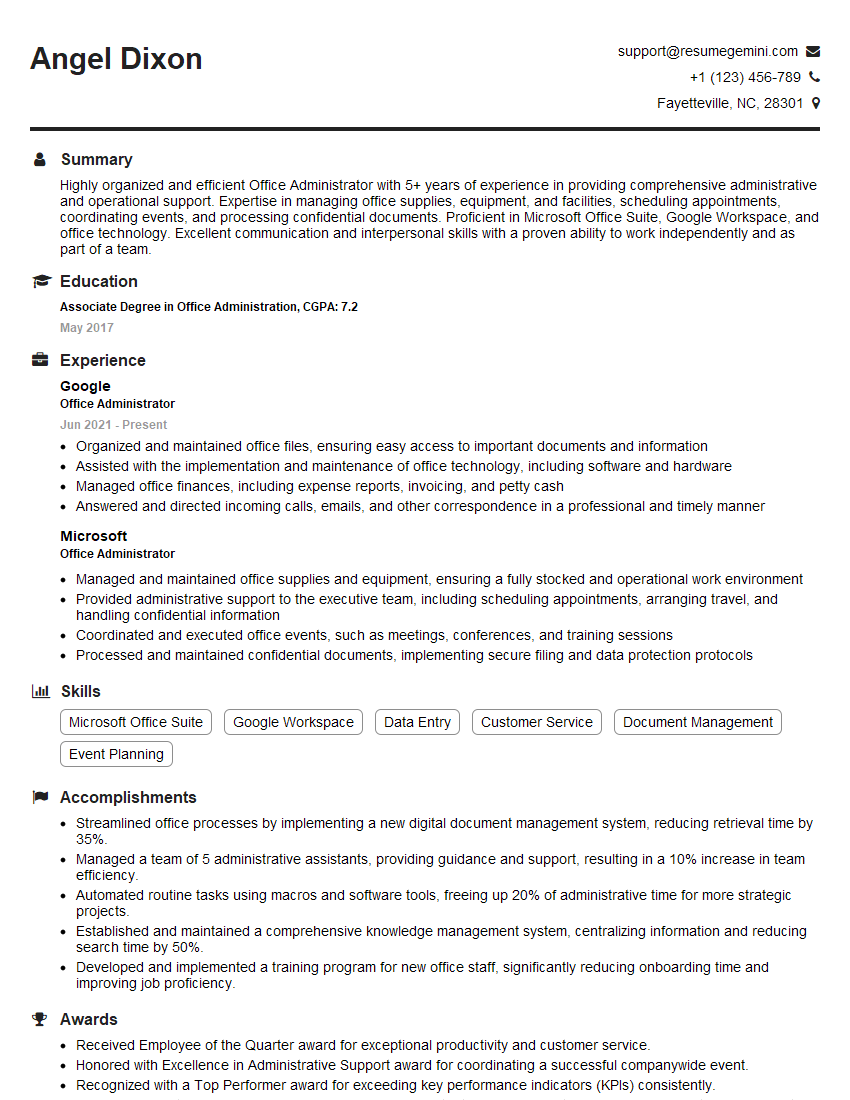Preparation is the key to success in any interview. In this post, we’ll explore crucial Calendar and Schedule Management interview questions and equip you with strategies to craft impactful answers. Whether you’re a beginner or a pro, these tips will elevate your preparation.
Questions Asked in Calendar and Schedule Management Interview
Q 1. Explain your experience with different calendar management software (e.g., Google Calendar, Outlook Calendar).
My experience with calendar management software spans several platforms, including Google Calendar and Outlook Calendar. I’m proficient in utilizing their core functionalities like scheduling appointments, setting reminders, creating recurring events, and managing multiple calendars. Google Calendar’s integration with other Google Workspace apps, particularly Gmail and Meet, is a key strength I leverage for seamless workflow. I find its intuitive interface and robust search function particularly useful for quickly locating specific events. Outlook Calendar, on the other hand, excels in its deep integration with the Microsoft ecosystem, particularly for users heavily invested in the Microsoft 365 suite. I’m adept at using its features like delegated access, resource scheduling, and its robust task management capabilities. In essence, my experience isn’t limited to just using these platforms; I understand their strengths and weaknesses and adapt my approach based on the specific needs of the project or team.
For example, when working on a large-scale project involving many stakeholders, Google Calendar’s shared calendar features are ideal for maintaining a unified view of everyone’s availability. In contrast, for managing highly sensitive appointments requiring granular access control, Outlook Calendar’s permission settings prove more valuable.
Q 2. How do you prioritize conflicting appointments or meetings?
Prioritizing conflicting appointments requires a structured approach. My strategy involves assessing the urgency and importance of each event using a prioritization matrix. I consider factors such as deadlines, potential consequences of missing the appointment, and the strategic importance of the meeting to my overall goals. I also consider the impact on other stakeholders and try to find a solution that minimizes disruptions to everyone’s schedules.
For instance, if a critical deadline-driven project meeting clashes with a less important routine meeting, I’d reschedule the latter. If both are high priority, I’d try to find alternative times or involve another team member to represent me in one of the meetings.
Sometimes, it involves a frank conversation with the involved parties to explain the conflict and collaboratively find a mutually acceptable solution. Transparency is key in these situations.
Q 3. Describe your method for managing multiple calendars simultaneously.
Managing multiple calendars effectively necessitates a system. I typically use color-coding to differentiate between work projects, personal appointments, and team calendars. Most calendar applications allow for this functionality. For example, I might use blue for work-related meetings, green for personal appointments, and red for urgent tasks. This visual distinction allows me to quickly identify the type of event and its relative importance. Moreover, I use the ‘overlay’ or ‘summary’ view available in most calendar platforms which gives a consolidated view of all calendars. This provides a comprehensive overview, highlighting potential conflicts or busy periods without having to look at each calendar individually.
Additionally, I utilize the filtering capabilities of the calendar apps to focus on specific calendars when necessary, ensuring I’m not overwhelmed by too much information at once.
Q 4. How do you handle last-minute scheduling requests?
Handling last-minute scheduling requests requires flexibility and clear communication. I first assess the urgency and impact of the request, checking my current schedule for any conflicts. If I have available time, I’ll gladly accommodate the request. However, if my schedule is already fully booked, I’ll communicate this professionally, offering alternative times or suggesting another colleague who might have availability. It’s crucial to respond promptly to avoid delays and maintain professionalism.
To prevent future occurrences of this situation, I may consider increasing my buffer time between scheduled events. I will also politely educate clients or colleagues about the importance of providing advance notice for appointments to avoid conflicts.
Q 5. What strategies do you use to ensure accuracy in scheduling?
Accuracy in scheduling is paramount. My strategies include double-checking all details – date, time, location, and participants – before confirming any appointment. I frequently utilize calendar reminders to avoid missing events. For important events, I set multiple reminders at increasing intervals to ensure I won’t overlook them. For recurring events, I carefully review the recurrence settings to ensure the events are generated correctly. I also maintain a detailed system of notes within the calendar events themselves, recording relevant details, decisions, action items and related documents.
Using the calendar’s notification system to alert attendees of any changes or updates keeps everyone informed. Finally, I regularly back up my calendar data to a separate location, a precaution against unexpected data loss. This ensures data security and access to the schedule in unforeseen circumstances.
Q 6. How do you effectively communicate schedule changes to stakeholders?
Communicating schedule changes effectively involves a multi-pronged approach. I utilize the calendar application’s built-in notification features to send automatic updates to all attendees. For significant changes, I supplement this with a brief email or instant message explaining the reason for the alteration. Transparency is key; I always provide a clear and concise explanation of why the change was necessary. If the change impacts multiple parties, I might consider a brief team announcement to keep everyone informed. The chosen communication method should align with the urgency and impact of the schedule change and the preferences of the stakeholders.
Q 7. Describe your process for creating and distributing meeting agendas.
Creating and distributing meeting agendas is a critical step in ensuring productive meetings. I start by defining clear objectives for the meeting and outlining the key topics to be discussed. I then allocate specific time slots for each agenda item, keeping in mind the overall meeting duration. The agenda includes action items, expected outcomes, and any pre-reading materials required. I create a concise and well-formatted document (often a shared Google Doc or similar collaborative tool), and distribute it to all participants well in advance of the meeting. This allows attendees to prepare accordingly and ensures everyone is on the same page.
For example, a typical agenda might include sections such as ‘Introductions (5 minutes)’, ‘Review of Project X Progress (15 minutes)’, ‘Discussion of Upcoming Challenges (20 minutes)’, ‘Action Items & Next Steps (10 minutes)’ and ‘Wrap-up (5 minutes)’. After the meeting, I distribute meeting minutes, summarizing key decisions and action items with assigned responsibilities. This ensures that everyone is clear on their roles and next steps.
Q 8. How do you manage recurring appointments and events?
Managing recurring appointments and events efficiently is crucial for maintaining a well-organized schedule. I leverage the recurring event functionality built into most calendar applications. This allows me to create an event once and specify its recurrence pattern – daily, weekly, monthly, yearly, or even custom intervals. For example, I might set a weekly team meeting to occur every Tuesday at 10 AM. The system automatically generates subsequent instances of the event based on the defined recurrence pattern.
Beyond basic recurrence, I also utilize advanced features like exception handling. This allows me to easily skip or modify individual instances of a recurring event without affecting the overall pattern. For instance, if a team member is unavailable on a particular Tuesday, I can easily mark that specific instance as an exception, preventing the meeting from being scheduled then. This ensures that recurring events are flexible and adapt to changing needs without the hassle of manual entry for each instance.
Furthermore, I always ensure the chosen recurrence pattern aligns with the event’s purpose. For instance, a monthly performance review would naturally use a monthly recurrence, while a daily exercise routine benefits from daily recurrence. This careful consideration prevents potential oversights or scheduling conflicts down the line.
Q 9. How familiar are you with time zone conversions and international scheduling?
I am very familiar with time zone conversions and international scheduling. This is vital for coordinating meetings and events across geographical boundaries. I use calendar applications that automatically handle time zone conversions, ensuring that all attendees see the meeting time in their local time zones. This eliminates confusion and guarantees everyone attends at the right time.
Beyond automatic conversions, I understand the importance of considering daylight saving time transitions and potential time zone differences within the same country. I meticulously double-check the time zones for each participant, especially when dealing with complex scheduling across multiple regions. For example, a meeting involving attendees in London, New York, and Sydney requires careful consideration of the differing time zones and any potential DST shifts. I often use online tools or apps to visualize the various time zones and ensure clarity for all participants. This attention to detail prevents missed meetings and misunderstandings.
Q 10. Explain how you handle scheduling conflicts between team members.
Handling scheduling conflicts is a key aspect of effective calendar management. My approach is proactive, relying on a combination of technology and communication. First, I utilize calendar software with features that automatically detect and highlight potential scheduling conflicts amongst team members. This allows me to see at a glance whether a proposed meeting clashes with others’ existing commitments.
If a conflict arises, I proactively communicate with the team members involved, explaining the issue and suggesting alternative time slots. I prioritize collaboration to find a suitable time for everyone. This may involve using a poll or survey to gather availability, ensuring everyone has a voice in determining the meeting time. In some cases, this might mean splitting the meeting into smaller groups or utilizing alternative communication methods for some participants if the conflicting schedules are truly irreconcilable. The goal is to find a solution that keeps everyone informed and minimizes disruption.
Q 11. Describe a time you had to reschedule a large event or meeting due to unforeseen circumstances.
During the planning of a large company-wide offsite, a major unforeseen circumstance arose – a severe weather warning was issued for the chosen location just days before the event. This impacted travel arrangements and participant safety.
My immediate action was to assess the situation, prioritizing safety and communication. I promptly informed all participants of the weather alert and the potential need for rescheduling. I explored alternative locations and dates, considering factors such as venue availability, participant travel constraints, and overall logistics.
Next, I communicated with all stakeholders – including the venue, caterers, and participants – to coordinate the rescheduling process. We decided on a new date and location, ensuring it was widely communicated and all necessary arrangements were updated accordingly. While this was a stressful situation, the proactive communication and decisive actions minimized disruption and ensured the event’s eventual success. The experience reinforced the importance of having a contingency plan for unforeseen circumstances when managing large events.
Q 12. How do you track and manage deadlines associated with scheduled events?
Tracking and managing deadlines associated with scheduled events is crucial for successful event management. I employ a multi-faceted approach. First, I include deadlines within the event details themselves in the calendar application – whether it’s a registration deadline, a presentation submission deadline, or a report due date. These act as in-calendar reminders.
Second, I use task management tools alongside my calendar, creating separate tasks linked to the relevant events. This approach separates time-bound tasks from the scheduled events, creating a detailed workflow and allowing for progress monitoring. For instance, a task might be “Send event invitations” three days before the actual event.
Finally, I integrate automated reminders and notifications, ensuring deadlines are not missed. These can range from email reminders to calendar alerts, offering a layered approach to ensure all tasks are completed on time, contributing to a well-managed and successful event.
Q 13. What methods do you use to ensure all scheduled appointments are properly documented?
Proper documentation of scheduled appointments is essential for accountability and future reference. My strategy involves utilizing a comprehensive system that combines digital and, in some cases, physical records.
I rely heavily on my calendar application, ensuring all appointments are clearly documented with detailed descriptions. This includes not just the time and location but also the agenda, participants, any relevant documents, and decisions made. Many calendar systems now allow for rich text notes and attachments.
In addition to digital records, for highly critical meetings or events, I maintain a separate physical file or notebook containing key details and supporting documentation. This serves as a backup and provides a readily accessible physical record. This combination of digital and physical documentation ensures that important details are captured and accessible, even in the event of technological failures.
Q 14. How do you proactively identify and prevent potential scheduling conflicts?
Proactive conflict prevention is key to efficient scheduling. I employ several strategies to minimize conflicts before they arise. Firstly, I encourage open communication and shared calendars. This allows all team members to view each other’s schedules, promoting awareness of potential clashes and facilitating collaboration in finding mutually agreeable times.
Secondly, I implement a system of pre-emptive scheduling. For recurring meetings or events, I book the time well in advance, increasing the likelihood of securing suitable slots and minimizing conflicts with other commitments. This might mean making weekly team meetings a permanent fixture in everyone’s calendar.
Finally, I regularly review the calendar to identify potential bottlenecks or overlaps. This proactive approach allows for early identification and resolution of conflicts, ensuring smooth workflow and minimal disruption to schedules. Regular calendar reviews are crucial to avoid scheduling problems from arising.
Q 15. How do you use technology to streamline the scheduling process?
Streamlining the scheduling process relies heavily on leveraging technology. I primarily use calendar applications like Google Calendar or Outlook Calendar, which allow for automated features and integrations. For instance, I utilize:
- Appointment Scheduling Tools: Services like Calendly or Acuity Scheduling automate appointment booking, eliminating back-and-forth emails and ensuring optimal time slot utilization. This is particularly useful when managing multiple stakeholders.
- Calendar Integrations: Linking my calendar to email and project management tools (Asana, Trello, etc.) creates a centralized view of all commitments, preventing double-booking and improving overall efficiency. For example, if a meeting is scheduled in Asana, it is automatically added to my calendar.
- Reminders and Notifications: Automated reminders reduce the risk of missed appointments and deadlines. I customize these reminders based on the importance and urgency of the event. For crucial meetings, I may set multiple reminders.
- Automated Email Responses: Using auto-responders for emails concerning scheduling ensures timely communication even when I’m unavailable or in meetings. This maintains professional consistency and sets clear expectations.
By combining these technological tools, I ensure that scheduling is not only efficient but also reduces manual effort and minimizes errors.
Career Expert Tips:
- Ace those interviews! Prepare effectively by reviewing the Top 50 Most Common Interview Questions on ResumeGemini.
- Navigate your job search with confidence! Explore a wide range of Career Tips on ResumeGemini. Learn about common challenges and recommendations to overcome them.
- Craft the perfect resume! Master the Art of Resume Writing with ResumeGemini’s guide. Showcase your unique qualifications and achievements effectively.
- Don’t miss out on holiday savings! Build your dream resume with ResumeGemini’s ATS optimized templates.
Q 16. Describe your experience with using scheduling templates.
Scheduling templates are invaluable for repetitive tasks. I frequently utilize them for recurring meetings, project milestones, or even personal appointments. For example:
- Recurring Team Meetings: I create a template with pre-set times, attendees, and agendas for weekly team meetings. This ensures consistency and reduces the time spent recreating meeting details every week.
- Project Phase Schedules: For large projects, I develop templates to outline crucial phases, deadlines, and resource allocation. This template is adapted for each new project, providing a consistent framework.
- Client Onboarding: I use a template to schedule initial consultations, follow-up calls, and deliverable deadlines for new clients, ensuring a smooth and standardized onboarding experience.
Templates reduce manual work, ensure consistency, and help maintain a structured approach to scheduling across various projects and engagements.
Q 17. How do you ensure the accuracy of scheduled events across various platforms?
Maintaining accuracy across platforms necessitates a centralized scheduling system. I ensure consistency by:
- Using a Master Calendar: I always maintain a single primary calendar (usually Google Calendar) as the source of truth. All other platforms sync to this master calendar to avoid discrepancies.
- Two-Way Syncing: I leverage two-way synchronization between my master calendar and other applications, ensuring updates made on one platform automatically reflect on others. This is crucial for maintaining consistency across my various devices.
- Regular Verification: I perform periodic checks to confirm data accuracy across different platforms, particularly after updates or changes. Manual checks, while time-consuming, are essential to eliminate potential errors.
- Careful Event Creation: When inputting events, I always double-check dates, times, attendees, and locations, ensuring the information is complete and error-free.
This multi-pronged approach minimizes the risk of conflicting information and maintains schedule accuracy regardless of the platform used.
Q 18. How do you balance multiple priorities and competing deadlines when scheduling?
Balancing multiple priorities requires a structured approach. I employ several strategies:
- Prioritization Matrix: I use a prioritization matrix (e.g., Eisenhower Matrix) to categorize tasks based on urgency and importance. This helps me focus on the most critical items first.
- Time Blocking: I allocate specific time blocks for different activities based on their priority. This prevents task switching and improves focus, allowing me to effectively manage competing deadlines.
- Visual Calendar: A color-coded calendar helps visualize workloads and identify potential conflicts. This allows for proactive adjustments to the schedule.
- Buffer Time: Incorporating buffer time between scheduled events provides flexibility for unexpected delays or interruptions. This minimizes stress and keeps the overall schedule on track.
This combined approach allows me to efficiently manage multiple priorities, ensuring all deadlines are met while maintaining a manageable workload.
Q 19. How do you handle requests that fall outside of established scheduling guidelines?
Requests outside established guidelines require careful consideration. My approach involves:
- Understanding the Rationale: I first inquire about the reason behind the request, understanding the context and the urgency of the situation.
- Assessing Feasibility: I evaluate the impact of the request on my existing schedule and other commitments. If feasible, I explore how to accommodate the request.
- Negotiating Alternatives: If immediate accommodation isn’t possible, I propose alternative times or solutions. This collaborative approach ensures mutual understanding and minimizes frustration.
- Setting Clear Expectations: If the request cannot be accommodated, I clearly communicate the reasons and set realistic expectations. Transparency is essential in maintaining positive relationships.
This approach balances flexibility with adherence to established guidelines, ensuring both productivity and positive stakeholder relationships.
Q 20. What are your strategies for improving time management and efficiency in scheduling?
Improving time management and efficiency in scheduling involves continuous refinement. My strategies include:
- Regular Review and Adjustment: I periodically review my schedule to identify areas for improvement, such as inefficient time allocation or recurring conflicts.
- Batching Similar Tasks: Grouping similar tasks together (e.g., responding to emails, making phone calls) improves focus and reduces context switching.
- Delegation: Where possible, I delegate tasks to free up my time for higher-priority activities. This maximizes efficiency and allows focus on strategic initiatives.
- Technology Optimization: I regularly explore new apps or features to automate routine tasks or enhance scheduling effectiveness.
Through ongoing self-assessment and adaptation, I continually improve my time management and scheduling efficiency.
Q 21. Describe your experience with managing complex schedules involving multiple individuals and teams.
Managing complex schedules involving multiple individuals and teams requires a collaborative and structured approach. I’ve successfully managed such situations by:
- Centralized Scheduling System: Using a shared calendar (like Google Calendar with shared access) allows everyone to view and manage their commitments simultaneously, minimizing conflicts and promoting transparency.
- Regular Communication and Coordination: Frequent check-ins and status updates with team members ensure everyone is aware of upcoming deadlines and potential scheduling challenges. This proactive approach helps mitigate issues before they arise.
- Clear Communication Protocols: Establishing clear communication protocols for scheduling changes, cancellations, or updates ensures consistency and prevents misunderstandings. This might include using specific subject lines or notification methods.
- Conflict Resolution Strategies: Proactive identification and resolution of scheduling conflicts are critical. This often involves open communication, negotiation, and finding mutually agreeable solutions.
This structured, collaborative approach ensures that complex schedules are effectively managed, maximizing team efficiency and minimizing conflicts.
Q 22. How do you ensure that all scheduled events are adequately prepared for and executed smoothly?
Ensuring smooth event execution starts long before the event itself. It’s a multi-stage process focusing on proactive planning, thorough preparation, and effective communication.
- Pre-Event Preparation: This involves detailed task breakdowns for each event. For example, if it’s a conference, this might include securing the venue, confirming speakers, managing registrations, arranging catering, and preparing marketing materials. I use project management tools to create checklists and assign responsibilities with deadlines. This prevents last-minute scrambling.
- Resource Allocation: Identifying and securing all necessary resources – personnel, equipment, materials – is crucial. Overbooking or under-resourcing can derail an event. I use resource scheduling tools to visually track availability and prevent conflicts.
- Communication & Confirmation: Consistent communication with all stakeholders is key. This includes sending timely confirmations, updates, and reminders. For instance, I might send automated emails to attendees a week and a day before an event, and then a final reminder a few hours prior. This minimizes confusion and ensures everyone is on the same page.
- Contingency Planning: No plan is foolproof. I always build in contingency plans to address potential issues. For example, having a backup speaker or venue in case of unforeseen circumstances. Thorough risk assessment is essential here.
- Post-Event Review: After the event, a thorough review identifies areas for improvement. This feedback loop is vital for continuous improvement. We might use surveys to gather feedback from attendees and analyze resource usage to optimize future events.
For instance, in my previous role, we used a combination of Asana and Google Calendar to manage a large-scale product launch event. The detailed task breakdowns and automated reminders ensured every detail was taken care of, resulting in a highly successful launch.
Q 23. What are your methods for monitoring the effectiveness of current scheduling procedures?
Monitoring scheduling effectiveness requires a multi-faceted approach combining qualitative and quantitative data. It’s not just about whether events happen on time; it’s about overall efficiency and impact.
- Data Analysis: I analyze key metrics such as event attendance rates, resource utilization, and time spent on preparation. This helps identify bottlenecks or areas of inefficiency. For example, if attendance is consistently low for a particular type of event, it indicates a need to re-evaluate the event’s format or target audience.
- Feedback Collection: Regularly gathering feedback from stakeholders – attendees, speakers, staff – provides valuable insights into areas that can be improved. This can be through surveys, feedback forms, or informal discussions.
- Process Benchmarking: Comparing current scheduling processes against best practices in the industry helps identify areas for optimization. Are our scheduling tools the most efficient? Could we streamline workflows? Are we maximizing resource allocation?
- Regular Reviews: Scheduling procedures shouldn’t be static. I advocate for regular reviews (e.g., quarterly or annually) to assess effectiveness and make necessary adjustments. This ensures the system adapts to changing needs and priorities.
In a previous project, we identified a significant time lag between event planning and execution through data analysis. By streamlining the approval process and implementing a more efficient communication system, we reduced the overall planning time by 30%, enhancing efficiency.
Q 24. How familiar are you with various scheduling methodologies (e.g., Kanban, Agile)?
I’m familiar with various scheduling methodologies and understand their strengths and weaknesses. The best method depends on the context of the project.
- Kanban: Kanban is excellent for visualizing workflow and managing tasks in a continuous flow. It’s particularly useful for managing repetitive tasks or projects with evolving requirements. I’ve used Kanban boards to track the progress of ongoing marketing campaigns, ensuring a smooth flow of content creation and publication.
- Agile: Agile methodologies, such as Scrum, are ideal for complex projects requiring iterative development and frequent adjustments. Agile’s emphasis on collaboration and flexibility makes it suitable for projects where requirements may change during the process. I’ve successfully applied Agile principles to project management involving multiple teams and dependencies.
- Traditional Gantt Charts: While seemingly less ‘trendy,’ Gantt charts are still very useful for visualizing project timelines and dependencies, particularly for larger, more structured projects with well-defined milestones. They’re excellent for identifying potential conflicts early on.
The choice of methodology isn’t about picking the ‘best’ one; it’s about selecting the one that aligns best with the project’s complexity, team dynamics, and desired outcome.
Q 25. How do you deal with no-shows or cancellations?
Dealing with no-shows and cancellations requires a proactive and organized approach to minimize disruption and recover from potential losses.
- Confirmation and Reminders: Robust confirmation and reminder systems (automated emails, phone calls) are essential to reduce no-shows. Personalized reminders increase the likelihood of attendance.
- Cancellation Policy: A clear and easily accessible cancellation policy outlines the consequences of cancellations and helps manage expectations. This policy should be communicated upfront.
- Waitlists: Maintaining a waitlist allows for immediate replacements for cancellations, maximizing resource utilization. This is especially important for events with limited capacity.
- Communication: Promptly communicating cancellations to affected parties (e.g., notifying those on the waitlist) is crucial to maintain transparency and manage expectations.
- Data Analysis: Tracking no-show rates and reasons for cancellations helps identify trends and improve strategies to minimize future occurrences. Perhaps the timing of the event is inconvenient, or the promotion was ineffective.
For example, we implemented a system where automated reminders were sent out 24 hours and 1 hour before the event, along with a clear cancellation policy that resulted in a noticeable decrease in no-shows.
Q 26. Explain your experience with setting up automated email reminders or notifications.
I have extensive experience setting up automated email reminders and notifications using various platforms, from simple email marketing services to more sophisticated CRM systems.
- Email Marketing Services: Services like Mailchimp or Constant Contact allow for easy scheduling and customization of email reminders. You can segment audiences and personalize messages based on attendee details.
- CRM Systems: Systems like Salesforce or HubSpot provide more advanced automation features, allowing for sophisticated workflows triggered by specific events (e.g., booking confirmation, date proximity). This allows for tailored communication strategies.
- Calendar Integration: Many calendar platforms (Google Calendar, Outlook) allow for setting reminders directly within the calendar, which can then trigger automated email notifications. This ensures that reminders are tightly integrated with the schedule.
- Testing and Refinement: It’s vital to test automated systems before deployment to ensure that emails are delivered correctly and the system functions as intended. Regularly monitoring delivery rates and click-through rates informs refinement.
In one instance, I set up a series of automated emails for a large-scale training program using HubSpot. These emails confirmed registration, provided pre-event instructions, sent reminders, and collected post-event feedback, streamlining the entire communication process.
Q 27. How do you maintain confidentiality when managing sensitive scheduling information?
Maintaining confidentiality when managing sensitive scheduling information is paramount. It requires a multifaceted approach.
- Access Control: Restricting access to sensitive scheduling information to only authorized personnel is crucial. This might involve using password-protected systems, role-based access controls, and encryption.
- Data Encryption: Encrypting sensitive data, both in transit and at rest, protects it from unauthorized access. This is particularly important for information stored in databases or cloud services.
- Secure Systems: Utilizing secure platforms and software for managing schedules ensures a higher level of protection. Regular software updates are vital to patch security vulnerabilities.
- Privacy Policies and Training: Implementing clear privacy policies and providing regular training to staff on data protection best practices reinforces the importance of confidentiality and outlines procedures for handling sensitive data.
- Compliance: Adherence to relevant data privacy regulations (e.g., GDPR, HIPAA) is essential. This may involve specific data handling protocols and reporting requirements.
For example, in a previous role involving client scheduling and confidential project timelines, I ensured all data was encrypted, access was restricted based on roles, and all staff were thoroughly trained on data privacy regulations.
Key Topics to Learn for Calendar and Schedule Management Interview
- Scheduling Fundamentals: Understanding different scheduling methodologies (e.g., resource-based, time-based), appointment types, and conflict resolution techniques.
- Calendar System Proficiency: Demonstrating expertise in various calendar applications (Google Calendar, Outlook Calendar, etc.), including features like recurring events, reminders, and shared calendars. Practical application: Explain how you’d handle a complex scheduling scenario involving multiple stakeholders and conflicting priorities.
- Time Management Strategies: Discuss effective time management techniques, prioritizing tasks, and optimizing workflows within a calendar system. Consider scenarios involving unexpected delays or urgent requests.
- Data Integration and APIs: Understanding how calendar systems integrate with other applications and the potential for API-driven automation. Explore scenarios involving data synchronization and potential challenges.
- Security and Access Control: Knowledge of best practices for managing user permissions, data security, and access control within a calendar system. Discuss potential security risks and mitigation strategies.
- Reporting and Analytics: Explain how calendar data can be used to generate reports, analyze trends, and improve scheduling efficiency. Consider examples of insightful reports you could create.
- Advanced Scheduling Concepts: Explore optimization algorithms, resource allocation strategies, and constraint satisfaction problems related to calendar management. This is particularly relevant for technical roles.
Next Steps
Mastering calendar and schedule management is crucial for success in today’s fast-paced work environment. Strong organizational skills and efficient scheduling are highly valued across many industries. To significantly boost your job prospects, invest time in creating an ATS-friendly resume that highlights your relevant skills and experience. ResumeGemini is a trusted resource that can help you build a professional and impactful resume tailored to your specific job search. We provide examples of resumes tailored to Calendar and Schedule Management to help guide you through the process. Take the next step towards your dream career today!
Explore more articles
Users Rating of Our Blogs
Share Your Experience
We value your feedback! Please rate our content and share your thoughts (optional).
What Readers Say About Our Blog
Hi, I’m Jay, we have a few potential clients that are interested in your services, thought you might be a good fit. I’d love to talk about the details, when do you have time to talk?
Best,
Jay
Founder | CEO


